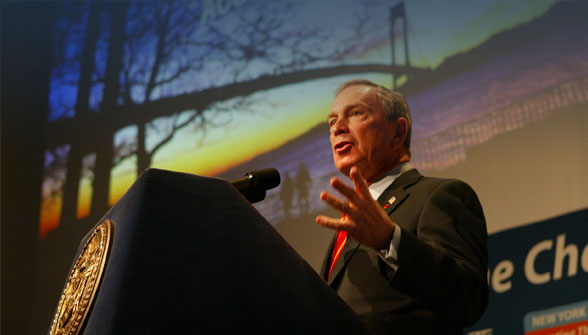It’s a cliché of life in New York: on even the chilliest winter days, windows are flung open to let free the over-cranked, inefficient steam heat. “We literally blow money out the window,” says Nancy Biberman, founder of the Bronx-based WHEDCo, a family and affordable housing non-profit. About a third of New York’s building supply was built before 1939 — long before sustainability and greenhouse gases were on anyone’s radar screen — and very little of it can be classified as green. That’s true of the newer housing stock too, for that matter; a recent study showed that New York trails many other major cities in its number of LEED buildings and green housing options.
 Find out what Bloomberg and other big-city bigwigs are up to in our list of green-leaning mayors.PlanNYC 2030Which means that nearly 80 percent of New York City’s carbon footprint comes from its energy-guzzling buildings. Thus the mayor announced last month that buildings bigger than 50,000 square feet would undergo a major overhaul, joining cities like Los Angeles and Seattle in a massive green building retrofit. Following the lead of the federal government (and inspired in part by stimulus funds), New York will now attempt to make existing buildings energy-efficient, lower their greenhouse gas emissions and remove their toxic innards. If all goes well, it will shrink that footprint 5 percent by 2022. Five percent may not sound like much, but it equates to cutting the carbon emissions of Oakland, Calif.
Find out what Bloomberg and other big-city bigwigs are up to in our list of green-leaning mayors.PlanNYC 2030Which means that nearly 80 percent of New York City’s carbon footprint comes from its energy-guzzling buildings. Thus the mayor announced last month that buildings bigger than 50,000 square feet would undergo a major overhaul, joining cities like Los Angeles and Seattle in a massive green building retrofit. Following the lead of the federal government (and inspired in part by stimulus funds), New York will now attempt to make existing buildings energy-efficient, lower their greenhouse gas emissions and remove their toxic innards. If all goes well, it will shrink that footprint 5 percent by 2022. Five percent may not sound like much, but it equates to cutting the carbon emissions of Oakland, Calif.
It would all begin, naturally, with a law, or several of them. The City Council is now weighing legislation that includes a new energy code—a kind of local LEED that existing buildings will have to adhere to after any renovation; a requirement that buildings larger than 50,000 square feet undertake energy audits every decade and make the necessary adjustments to meet that code; and a requirement that such buildings switch to energy-efficient lighting (an improvement, they say, that pays for itself almost immediately).
The new plan will be financed in part by $16 million in federal stimulus funds, starting sometime around 2013, with changes to be made within a decade or so to 22,000 buildings. The city estimates it would reduce energy costs by $750 million a year and create 20,000 or so of those green jobs we’ve been hearing so much about, from construction workers to energy auditors, who track down everything from air leaks to inefficient boilers to inadequate windows.
Of course, after such an audit, it’s the owners who have to pay for the improvements. What’s to prevent the powerful real estate lobby from rabidly opposing the legislation? Biberman, whose WHEDCo non-profit owns and operates several properties in the Bronx, says the investment is worth it, and quickly: “If you replace an old boiler with an efficient one, the payback is immediate.”
WHEDCo began re-renovating a 10-story, 132-unit building in 2005, primarily to reduce operating costs. “Some of the things we found were relatively easy to remedy — just plug up the holes,” Biberman says. The windows, that infamous leaky heat, the air whooshing out the doorjamb — that’s the “low hanging fruit.” Boilers, though quickly offering a return on investment, require more cash up front. After spending $200,000 on that retrofit, WHEDCo has seen tens of thousands of dollars of savings, and expects to recoup the bulk of its investment within four years.
This is the kind of model the city wants to promote. Property owners, suddenly responsible for monitoring their buildings’ carbon footprint and then making changes to shrink it, can borrow a chunk of that federal stimulus money, translated into real estate loans. Spend the cash to replace those things, the philosophy goes, and landlords will make it back in utility bills within five years — if it’ll take longer than that, the city won’t insist on the repairs.
The real mystery is how to police energy efficiency — will those energy auditors become covert green building spies after their work is through, or will there be enough stimulus money to create a continual auditing office? Will we someday see closed windows in the winter in all New York buildings? “Financing the upgrades is not really problematic,” says Biberman. “How do you enforce it — that’s the heart of the matter.”
The buildings department, says City Council spokesperson Andrew Doba, will have that task added to their building inspection duties — but government staffers don’t think it’ll be too hard to push, what with the unreliable price of oil and stale real estate market. Says Doba, “We don’t think it’s onerous enough to get a lot of backlash.”



